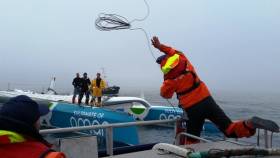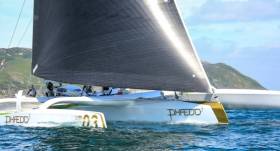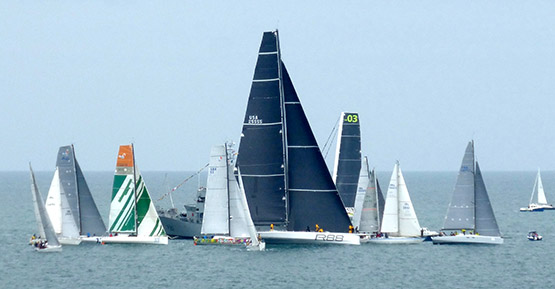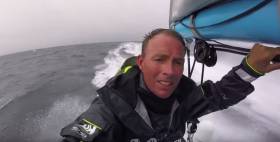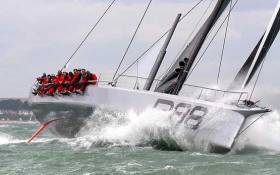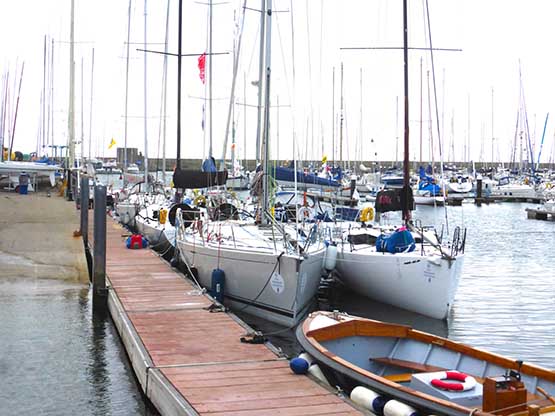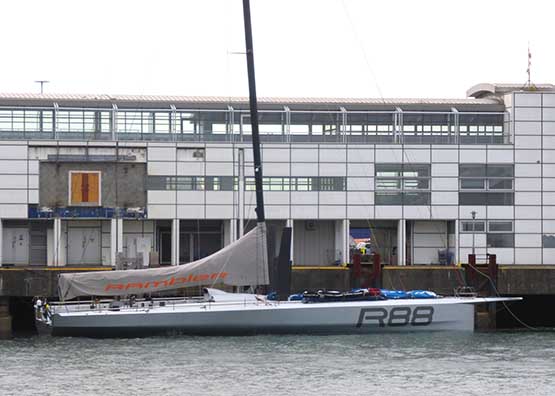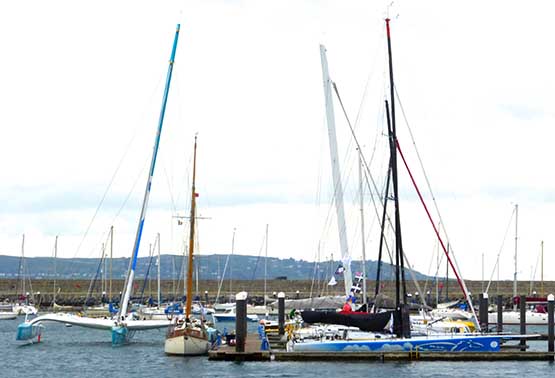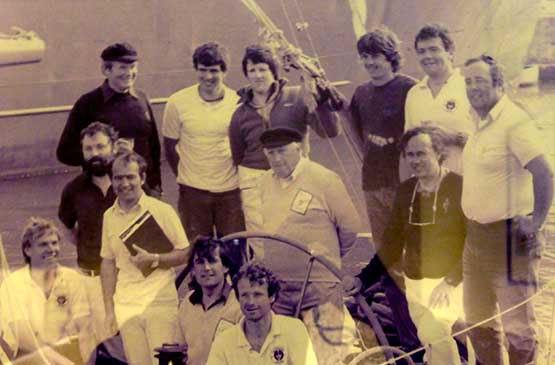Displaying items by tag: MOD70
Peter Cunningham’s PowerPlay Racing Team is the first to finish the 90th edition of the Round the Island Race.
MOD70 PowerPlay, with Peter Cunningham on the helm, finished the race at 10:51:01 BST (09:51:01 UTC) in an elapsed time of 4hrs 11mins 01secs.
A light start to the race prevented any chance of beating the race record, set by PowerPlay, as Concise 10 in 2017 (2hrs 22mins and 23 secs). PowerPlay finished this year's race ahead of the ULTIM Actual and the 32m trimaran IDEC.
 MOD70 PowerPlay crew: Peter Cunningham (Helm), Ned Collier Wakefield (Skipper), Tom Dawson, Miles Seddon, Paul Larsen, Nick Hutton, Frank Gerber, Martin Watts, John Hamilton.
MOD70 PowerPlay crew: Peter Cunningham (Helm), Ned Collier Wakefield (Skipper), Tom Dawson, Miles Seddon, Paul Larsen, Nick Hutton, Frank Gerber, Martin Watts, John Hamilton.
MOD70 Trimaran PowerPlay, led by Peter Cunningham and skippered by Ned Collier Wakefield, has completed the original Fastnet Course of 595 nautical miles in a new world record of 25hrs 04mins 18secs. *Subject to ratification by the World Sailing Speed Record Council.
“It was kind of ambitious, but the conditions were right, and the team was ready to go,” commented Peter Cunningham. “The PowerPlay crew was fantastic. Miles (Seddon) did a brilliant job navigating, we had two wonderful drivers in Ned Collier Wakefield, who set up the boat and runs the programme, and the fastest sailor on Earth, Paul Larsen, who drove in some incredibly bad conditions.”
 PowerPlay rounded the famous Fastnet Lighthouse off the coast of County Cork on Monday night. The historic 595nm course starts from Cowes IOW, around Lands' End, across the Celtic Sea, around the Fastnet Lighthouse off the coast of Ireland, and finishing at the Plymouth Breakwater.
PowerPlay rounded the famous Fastnet Lighthouse off the coast of County Cork on Monday night. The historic 595nm course starts from Cowes IOW, around Lands' End, across the Celtic Sea, around the Fastnet Lighthouse off the coast of Ireland, and finishing at the Plymouth Breakwater.
Shortly after midday on Monday 05 April, in a bitterly cold strong northerly wind. PowerPlay started their Fastnet record attempt on the Squadron Line at Cowes. PowerPlay made short work of racing to Lands' End and powered across the Celtic Sea at speeds in excess of 30 knots. PowerPlay rounded the famous Fastnet Lighthouse and raced through the night. On Tuesday 06 April, at 13:42 and 19 seconds BST, PowerPlay reached the Plymouth Breakwater, where the team celebrated their amazing run of 25 hours, 4 minutes and 18 seconds.
 The PowerPlay team celebrated their amazing run of 25 hours, 4 minutes and 18 seconds Photo: Lloyd images
The PowerPlay team celebrated their amazing run of 25 hours, 4 minutes and 18 seconds Photo: Lloyd images
“We didn’t leave much out there, we were pushing really hard and everything aligned,” commented PowerPlay Skipper Ned Collier Wakefield. “I am not going to lie, it was pretty full on, especially in April with an arctic northerly with snow around. With the apparent wind we saw 50 knots over the deck, and we hit a top speed of just under 40 knots. The lads did a brilliant job, changing sails about every half an hour – It was rough, physical and very cold. As a crew we have done cumulatively over 50 Fastnet Races, we love the course and to do it faster than it has been done before is really cool.”
 PowerPlay Crew for Fastnet Course Record: Peter Cunningham, Ned Collier Wakefield, Tom Dawson, John Hamilton, Paul Larsen, Jack Trigger, Miles Seddon, Martin Watts. Photo: Lloyd images
PowerPlay Crew for Fastnet Course Record: Peter Cunningham, Ned Collier Wakefield, Tom Dawson, John Hamilton, Paul Larsen, Jack Trigger, Miles Seddon, Martin Watts. Photo: Lloyd images
The historic 595nm course starts from Cowes IOW, around Lands' End, across the Celtic Sea, around the Fastnet Lighthouse off the coast of Ireland, and finishing at the Plymouth Breakwater.
PowerPlay’s run is over two hours quicker than the record set by Phaedo3 in 2015.
The first Fastnet Race was in 1925 and won by Jolie Brise which took over six days to finish the course.
Round Ireland Speed Record Breaker Phaedo3 Takes Line Honours In Tenth Artemis Challenge
Round Ireland speed sailing record breaker Phaedo3 skipper Lloyd Thornburg, who will be at the National Yacht Club tonight to celebrate that circumnavigation, picked up another prize yesterday when the American took line honours in the tenth edition of the Artemis Challenge at Aberdeen Asset Management Cowes Week.
Screaming around the Isle of Wight at top speeds of over 30 knots, Thornburg's MOD70 covered the 50 nautical mile course in three hours and 56 seconds, 50 minutes ahead of M32 Tranwall.
Powering over the Royal Yacht Squadron start line in a flash of gold and white, Phaedo3 flew past the Needles at 27 knots. Executing just three tacks the along the north west coast past Yarmouth, the boat was on pace with the world record holder Foncia.
Despite their rapid speed and sheer determination, light conditions on the south east side of the Island put paid to any record breaking runs, with the current world record set by Michel Desjoyeaux and Foncia in the 2012 edition of the race out of reach at two hours, 21 minutes and 25 seconds.
Despite the sheer size of Phaedo3, M32 Tranwall was hot on the stern of the MOD70. On the approach to Saint Catherine's lighthouse, the 32-foot match-racing catamaran achieved speeds of 21 knots and was just five miles behind the ocean racing giant - not bad for a catamaran measuring in at less than half the size of the giant trimaran's hulls.
In what was the first time an M32 has competed in the Artemis Challenge, the Tranwall crew set their own benchmark today, completing the charity sprint in three hours, 58 minutes and one second.
Oman Sail Trimaran Successfully Recovered & Bound For France
Damian Foxall might be on course for yet a new record this morning off the West Coast of Ireland but the County Kerry Round the World sailor will spare a thought for his previous craft, the current record holder, the Oman Sail MOD70, Musandam-Oman Sail that is preparing for a tow back across the Atlantic Ocean for repairs.
The Arab MOD70 capsized off the Canadian Coast in July when a Transatlantic record attempt went wrong with Foxall on board. There's still no news on how the giant trimaran capsized.
The crew were rescued by a passing cargo ship and a giant recovery operation then followed. The crew, inlcuding Foxall, went back out into the Atlantic, found it five days later and recovered the broken rig boom and sails by diving. They righted the 70–foot hull mid–Atlantic, towed it back across Grand Banks to St Pierre et Miquelon where it is now lies. An Oman Sail spokeswoman told Afloat.ie: 'we are working on getting the boat back to France'.
Phaedo Approaches Halfway Stage In Round Ireland Speed Challenge
Lloyd Thornburg’s MOD 70 was past Achill Island in Mayo this morning by 0700 in her anti-clockwise Round Ireland record attempt, which began at Dublin Bay Bay’s Kish Lighthouse at 3.0 pm yesterday afternoon writes W M Nixon. But though she had more wind than she needed for much of yesterday, the sting has gone out of the westerly breeze off the Connacht, coast and off Clew Bay at 0710 hrs she was doing a relatively modest 15.1 knots on track southward. See tracker here.
With the fresh winds veering towards west to nor’west as she came onto the north coast, as expected Phaedo had to beat from Torr Head to Malin Head. But with her enormous speed potential, it was an advantage that the tide was flooding adversely southeast into the North Channel, as it this eliminated the area’s Maelstrom-like conditions when it’s wind over tide, and the boat’s extraordinary speed enabled her to offset strong adverse tidal stream.
Phaedo showed her quality by taking just four hours and forty minutes to beat from Torr Head (where she was making 19.3 nots) to Malin Head, and with Malin finally astern at 00.40 hrs this (Thursday) morning, she was finally able to lay the course past Tory Island and then free still further for potentially faster progress towards the northwest headlands of Mayo.
But with the sea state somewhat confused after two days of strong winds, and the bite in the nor’west and then westerly breeze sometimes weakening, she hasn’t always been at her full speed potential. Though she was at 25.7 knots approaching Achill Head at 0640 this morning, once past it the pace slackened for a while, but now at 07.35 things are looking up again, and she’s making 29.1 knots
Round Ireland Speed Record Tracker CLICK HERE!
Track the Round Ireland speed record attempt by the MOD70 Phaedo3 Lloyd Thornburg below.
The record time to beat is: 38 hours, 37 minutes and 7 seconds.
Stay tuned to the Yellowbrick tracker below.
At 704 miles long, with a course along coastlines of almost infinite variety, the Round Ireland Race was always a complex event for post-race analysis even when fleets amounted to only three dozen or so. But for 2016 in the first year of sponsorship by Volvo Car Ireland, the number of starters soared to 63. And the inclusion of multi-hulls for the first time since the initial pre-RORC race of 1980 added further depth to the eclectic nature of the fleet, which was already an extensive array, as it ranged from small craft like a J/97, a First 31.7 and a Sunfast 3200, to one of the current superstars of world sailing, George David’s Juan K-designed canting-keeled Rambler 88. Having provided us with 17 up-dates during the six days of the race, W M Nixon takes a final overview.
Here’s to Yellowbrick, the friend of armchair sailors everywhere. In the old days, trying to analyse or explain the unfolding story of the biennial Round Ireland Race was a formidable challenge. And you could be talking about it to people very few of whom had ever sailed round Ireland, while others didn’t even know it from the land, as they have been availing of sunshine holidays ever since cheap air travel arrived.
Thus there are many who know more of the coasts of Spain, Portugal and Greece – or even the Scottish Hebrides and the Isles of Scilly - than they do of Mayo and Donegal. And having experienced both those Irish counties in their more perverse meteorological moods in the course of several races round Ireland - not to mention many non-racing cruising circuits – I have to admit that I can see their point of view.
The Yellowbrick tracker for the Volvo Round Ireland Race 2016 wraps Ireland in its web. TriLogic went furthest east after the start, the three MOD 70s went furthest south off the south coast and furthest west off the west coast, Rambler 88 went furthest northwest, and Pegasus of Northumberland went to the Isle of Man but came back to cross tacks yet again with Teasing Machine, this time at Skerries as the Machine came south from Dundalk Bay.
"Round Ireland 2016 is in a special league of its own"
Yet the round Ireland race is addictive, and for those who have done it in the past, particularly those who have done it several times, it’s a bit of a pang to see the fleet go off and not be part of it. Even with all the modern equipment and boats which are obviously faster, it’s still a very worthy challenge. And it induces a special post-race camaraderie among crews who, in racing terms, have been at each other’s throats since the start.
After each biennial staging, something new has always turned up to add to the sailing history books. But the Volvo Round Ireland Race 2016 is in a special league of its own in this category, so much so that far from just adding something to the history books, it probably deserves a book of its own.
In fact, you could write a book about the fantastic start in which Rambler 88 gave a Masterclass in discerning emerging gaps beginning to appear in a melee of sometimes confused smaller bats. Despite her huge beam she came cleanly through to a peach of a start right on the committee vessel LE Aisling, bettered only by Eric de Turckheim’s A13 Teasing Machine while smaller craft which thought they’d done better found they’d been OCS, which led to a slow and painful return against a strengthening ebb to re-start.
Rambler’s miraculous start, finding gaps where none had existed ten seconds earlier. Photo: W M Nixon
Fortunately in making some sense of what happened afterwards, we can take a precise positional overview by looking at the Yellowbrick tracking as it was at virtual completion yesterday afternoon. It may look like a right cat’s cradle of lines all eventually getting back to Wicklow, but there are stories to be drawn from every part of it.
In the first beat from Wicklow Head down to the Tuskar Rock, very few boats tended to the east, and it certainly didn’t pay off. The one who went furthest east was the 50ft Trilogic, Hugo Carlsson-Smythe’s trimaran, which ultimately retired during the course of the race with gear and sail problem, so we don’t know if ultimately she would have overcome this initial tactical error.
The mono-hull which tacked furthest east was Chris & Patanne Power Smith’s J/122 Aurelia (RStGYC), but she then put in a good showing in the long beat along the south coast and got herself back in the hunt, although off the north and east coasts things didn’t go quite so well, but in the end she placed 3rd in IRC 2 and 18th in IRC overall.
"Teasing Machine made a proper job of tide-dodging"
While the bulk of the fleet were still struggling against foul tides down the Wexford coast with Teasing Machine showing how to make a proper job of tide-dodging inside the Wexford banks, out ahead the biggies were splitting into their two parts of this fleet of four parts.
Although the reckoning was that conditions might just fall the right way for a new record, the three MOD 70s first had to find a breeze to raise them above the 12 knots which they occasionally fell back to as they came on starboard out past the Coningbeg Light. Thus it’s Musandam-Oman, Phaedo and Concise which are those three tracks which go way to the south. As they were so close to each other in performance, they sailed as a pack, so there was an element of covering as much as strategy in this, but in these early stages it was Ned Colllier Wakefield aboard Concise who was making the pace, with Phaedo next in line, while Musandam seemed to find it difficult to obtain quite the same speed.

The first hint of light in the east in the sky as the MOD 70 Musandam-Oman closes in on the Wicklow finish for a last-minute takeover of the line honours lead on the water, after her sister-ship Team Concise had led for most of the race. Photo: Mark Lloyd
Perhaps Irish sailing superstar Damian Foxall aboard Musadnam was slightly over-awed by it all, as he hadn’t been aboard Musandam when she set the new open Round Ireland record back in May 2015, and in an interview before the race (see below), he revealed that he and Justin Slattery – who was on Lloyd Thornburg’s Phaedo - were both Round Ireland virgins. They’ve been so busy building their international careers in other parts of the world that racing round their home island had never come up on the radar.
Whatever the reason, it was Concise which was least fazed by the challenge, she stayed closely in the lead, and after they’d tacked and started ripping up the west coast in the rising sou’west winds of Sunday, it was Concise which recorded the MOD 70’s best speed of 41.56 knots. But as they admitted afterwards, they weren’t right on the edge when they his that mega-speed in a growing Atlantic swell – they were beyond it.

Just outside a two day elapsed time, George David's Rambler looked every inch a winner in her debut Round Ireland race. Photo: Afloat.ie
After her glorious start ten minutes ahead of the MOD 70s, Rambler was going so well in the moderate southerly that she was past Arklow before the trimarans came through, but soon they’d disappeared ahead, and thus for the reminder of the race Rambler 88 was entirely on her own, thereby providing Part 2 of our four part round Ireland fleet. Although she’d been holding the IRC overall lead for a while, at various stages she’d dropped back as smaller craft got clear of foul tides. But once she was past the Fastnet and beginning to build her speed up the west coast in rising breezes, she was soon featuring among the front runners on all counts.
If anything, the weather felt almost Autumnal off the west coast, it had seemed slightly spring-like as warmer weather spread in while the leading big boats were far at sea seeking breezes off the south coast, and there was decent sunshine while the larger boats of the fleet were shuttling from Dun Laoghaire down to Wicklow on the Saturday morning for the start. But on the Thursday night in Dun Laoghaire when it was open house at the Royal Irish YC to meet the heavy hitters, a local weather anomaly was giving a temperature of 9 degrees Celsius which had been winter by anyone’s standards, it was certainly experienced but fortunately it wasn’t to occur again.
With the leading big boats zapping up the west coast on Sunday as south to sou’west winds continued to freshen, records were once again top of the agenda. But this was all of academic interest to the main part of the fleet bashing its way along the south coast, for as Sunday went on, conditions became increasingly rugged. Yet it was not without its local oddities – for a period on Sunday afternoon, there was very little wind indeed in an area close in on the entrance to Cork Harbour, and the spread of breeze was so uneven that the tracker revealed some boats taking rather desperate gambles to try and find steadier conditions.

Mark Mansfield and Maurice “The Prof” O’Connell on Dave Cullen's J109 Euro Car Parks, the IRC3 winners. Photo: Afloat.ie
One boat which did notably well during this stage was Dave Cullen’s J/109 Euro Car Parks. With Corkmen Mark Mansfield and Maurice “The Prof” O’Connell calling the shots, they gave a masterful demonstration of how to work the bays slugging west beyond the Old Head of Kinsale.
“Working the bays” doesn’t necessarily always pay off, and in fact it didn’t work so well for other boats near Euro Car Parks. So clearly an important factor in the successful use of this ploy is to have a boat which is out-sailing everyone else in any case, and it was noticeable by this stage that Euro Car Parks had worked out a formidable lead on all the other J/109s while she herself was in hot pursuit of Paul O’Higgins new JPK 10.80 Rockabill VI, racing with the noted talents of Mark Pettit and Brian Mathews on board.
"Rockabill VI was a very slippy performer"
As Sunday evening and night went on, the Fastnet became increasingly difficult to get past as the area of steadier fresher breeze moved to the north. Thus while bigger boats such as Alan Hannon’s Reichel-Pugh 45 was making hay up past the Blaskets with a performance which suggested that she a going better and better as her Lough Swilly YC crew became accustomed to her ways, back down the line off the mouths of the great rias of the southwest at times the wind was all over the place, and Euro Car Parks was one which suffered, head off south of Dursey Dound, and forced to tack seaward in unspeakably lumpy sailing conditions.
By this time Rockabill VI was showing she was a very slippy performer, and the long run up the west coast was brilliantly sailed by her talented crew, so much so that by Tory Island she’d opened out a lead of 40 miles on Euro Car Parks, which looked unassailable.
But for others even thinking about Tory Island was still way off the radar, as many boats reckoned they’d taken a ferocious battering through the latter part of Sunday, and there were retirals at all levels of the fleet. Meanwhile away to the east the oldest boat in the race, Darryl Hughes’s 1937 Tyrell of Arklow 43ft–gaff ketch Maybird was making only very slow progress and she’d sustained damage aloft and to sails, so she went into Dunmore East and kept the crew strictly on board and out of contact with the shore while they made repairs and then, most gallantly, they put to sea again and eventually after another two days of slow progress to windward they had the freeing of sheets at Mizen Head within sight, but then it was discovered that there was a major problem with the engine, so they retired regretfully into Baltimore.
By this time the great dramas of the record finishes at Wicklow had been played out through Monday. So long as there’s breeze your ordinary North Channel fair or foul tides aren’t the major consideration for he MOD 70s, it’s the presence of wind which is the primary consideration.
Sunday evening found the MOD 70s shaping themselves into the North Channel and fetching through with all still close together and Concise still just leading, but from the South Rock on it was hard on the wind or beating to get to Wicklow. Musandam was still trailing the other two, so she took a brief slant towards Dundalk Bay and then went on to starboard to pace with them about two mioles further westward, bringing her in closer to Howth than Concise or Phaedo, and putting her in a better breeze as the wind started to play tricks in the dark of the small hours off Bray.
Everything was gettingly nail-bitingly tense, and south of Greystones, Phaedo and Concise were slowing markedly, so Musandam came up from astern and took a bit of an offing, finding better breeze only a short distance offshore which carried her right to the line at Wicklow to finish ahead and created an absurd new record of 1 day 14 hours and 37 minutes, with Phaedo 3 six minutes astern, and Concise – which had so gallantly led for most of the race – coming in another minute later.
Follow that, as they say, but somehow Rambler 88 managed to outdo the drama, as she did the final stage from Rathlin Island to Wicklow in just part of the one span of daylight on Monday. But by the time she came calling the wind had veered and thus she was able to lay the whole way down the Irish Sea to the finish, and was travelling at full chat as she came into the line.
While a mono-hull record within two days was no longer possible as she’d sailed 790 miles in all thanks to that long tack to the south in search of better breeze through Saturday night and Sunday morning, nevertheless she still made an almighty dent in every other mono-hull record by finishing in a time of 2 days 2 hours 24 minute and 9 seconds.
There was still some bite to the winds, but even in a poor summer such as we’re currently experiencing, the fact that the sou’west to west breeze had now been blowing moderate to strong and more for more than three days was increasing the likelihood of calm patches, and a general falling away in wind strength.
So gradually the crazy notion took hold that not only would the popular Rambler 88 be lauded as the new all-out mono-hull record holder, but she might even manage to win the race on corrected time. Certainly the holes in the wind now began to appear with increasing frequency, and none more so than for Rockabill VI as she rounded Inishtrahull, the most northerly point of the course, on Tuesday.

Rockabill VI – a new JPK 10.80 design. Photo: Afloat.ie
The O’Higgins crew came up against what was soon known as the Great Glass Wall of Inishtrahull. Rockabill and the three other boats in her immediate neighbourhood all came to such a complete halt that tracker-followers assumed they must all have fouled lobster pots. But they were simply and totally becalmed. They made no progress for three hours, yet boats close to the east were still bustling busily towards Rathlin Island, while boats close to the west were trundling merrily in from Tory.
So after the episodes of winter and spring and autumn, Rockabill was experiencing a brief bit of summer she could have well done without. Finally she got going again, but by this time Euro Car Parks had sliced a huge 20 miles out of Rockabill’s 40 mile lead, and thereafter it was Euro Car Parks ahead in IRC 3 on corrected time. In other classes, solid performances and reliability in strong winds had been rewarded, and in IR2 the beautifully-prepared Cornish-based Swan 47 Sarabande (Rob Mabley) had a lead she held to the finish, while in IRC 4 we were witnessing one of the great performances in the race, with Patrice Carpentier’s Sunfast 3200 GROUPE V tenaciously staying in front throughout, quite a showing as she was also leading the two-handed division.
As the race drew to a close through Wednesday and Thursday for this main part of the fleet, other consistent performances were being rewarded. Eric de Turckheim’s Teasing Machine was both consistent and brilliant, and on Wednesday tacking down the southern part of the North Channel, she was neck and neck with Ross Hobson’s two-handed canting-keeled Open 50 Pegasus of Northumberland.

French entry Teasing Machine was both consistent and brilliant. Photo: Afloat.ie
But while Pegasus elected to continue on starboard right over to the Isle of Man as can be seen on the tracker plan, Teasing Machine’s crew took a completely different choice, they went right to the southwest, and then tacked to curve across Dundalk Bay close past Clogher Head until the two boats met again at Rockabill, following which they paced together down to Wicklow where a bit of slick tacking saw Teasing Machine finish ahead, but by this time it was akin to bear-baiting, as the crew of the big Pegasus were boggle-eyed with exhaustion.
Teasing Machine’s time put her behind Rambler 88 on corrected, so the crazy dream was becoming reality, but that is in no way to detract from the de Turkheim crew’s performance, it was a superb playing of the hand they’d been dealt, They were comfortably ahead of Class 1 and 2, and soon out of sight on the determined little battlers of Classes 3 and 4, who until then had been snapping at their heels.
Meanwhile, between the big’ uns well finished, and the little’ uns still battling far at sea, there were several Steady Eddy performances whose reward was on its way, and none more so than for RORC Commodore Michael Boyd of the Royal Irish YC. His Fist 44.7 Lise was always there or thereabouts, and on Wednesday evening she was off Dublin Bay as the tide turned foul, but she kept beating on steadily towards Wicklow and got finished before midnight with the bonus of a local breeze, and was immediately sitting pretty at second in Class I well ahead of Katsu in third, and looking good for third overall behind Rambler and Teasing Machine.
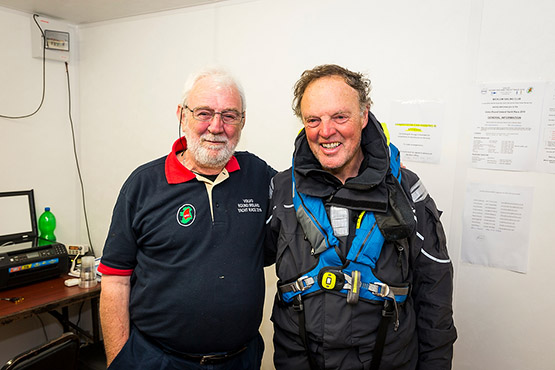
Midnight encounter. Race organiser Theo Phelan with RORC Commodore Michael Boyd after the latter had brought the First 44.7 Lisa across the Wicklow finish line to take third overall. Photo: David Branigan
But that third overall needed a bit of waiting, as the Class 3 front-runners of Euro Car Parks and Rockabill VI were still in with a chance, while Class 4’s GROUPE V and Stephen Quinn’s gallant little J/97 Lambay Rules were also in contention, but it was not to be. The minutes slipped away, the hours ticked by, and in the end over a course of 704 miles it was waterline length which counted as a fading breeze and much windward work saw the little ‘uns lose out. But my word, they had one impressive race amongst themselves.
The results are still being analysed as we write this, and it was only on the Friday that Rambler was finally confirmed as overall winner, with Teasing Machine second and Lisa Third. As for Class winners, they were (1) Teasing Machine, (2) Sarabande, (3) Euro Car Parks, and (4) GROUPE V, but GROUPE V lost her two-handed class lead to Begian Michael Kleinjans’ Open 40 Roaring Forty 2 which was another steady performer.
"All credit to Wicklow Sailing Club’s Theo Phelan and his team"
In all, it was a wonderful race, a magnificent sporting event from which any keen sailor can take much of interest and even more of entertainment and excitement. All credit to Wicklow Sailing Club’s Theo Phelan and his team who have kept this event going through the thin times, and have been ready and waiting to see it come to a new flowering with sponsorship from Volvo Car Ireland.
But all the background organization would have been meaningless without a fleet of boats and their crews game to take on the 704-mile circuit of an island set in an exposed location on the lee side of the Atlantic ocean, and in following this race it has been particularly encouraging to see the improving performances of certain boats as their relatively novice crews get to grips with the challenge they’ve taken on. Needless to say it was also a case of the Old Dog for the Long Road, and Ian Hickey’s Granada 38 Cavatina was again in the frame at the fiish in Class 4.

Top of the class - a notable performance by the sailing school crew from the INSS in Dun Laoghaire. Photo: Afloat.ie
Notably outstanding was the Irish National Sailing School’s Reflex 38 Lynx from Dun Laoghaire, skippered by Kenneth Rumball. She was always in competition, but as the race went on she seemed more in competition than ever, until at the finish she clocked in at fourth among all those hotshots in Class 3, close astern of Conor Fogerty’s Sunfast 3600 Bam at third, and placed tenth overall in fleet. The crew of Lynx have had one excellent lesson in offshore racing.

The essential post-race de-briefing – the crews of Euro Car Parks and Rockabill VI, leaders in Class 3, get together in Wicklow SC on Thursday afternoon after five days of racing against each other round Ireland. Photo: W M Nixon
Volvo Round Ireland 2016 selected results
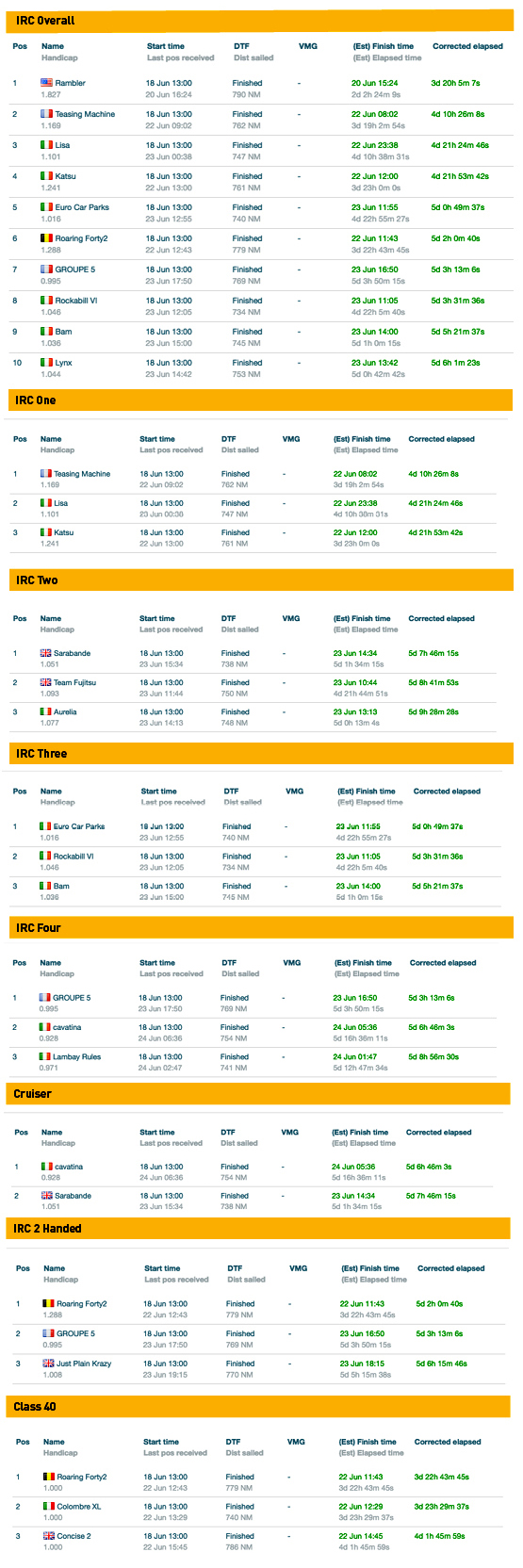
See Round Ireland tracker here Afloat's Round Ireland 2016 coverage is here and download overall results here
MOD70 Round Ireland Video By Concise 10
Sit down, strap yourself in and get ready to experience the rollercoaster ride that was the Volvo Round Ireland Race 2016. Here's the MOD70 Concise 10's video take of their epic circumnavigation in one day 14 hours and 44 minutes. They hit a top speed of 44.56 knots!
See Round Ireland tracker here and keep to up to date with the fleet's progress with Afloat's regular Round Ireland 2016 updates here
New Round Ireland Records Top Of The Agenda At Wicklow Today
Today sees the start off the Wicklow Pierheads of largest and most varied fleet in the 36-year history of the biennial Round Ireland Race from, which in its 19th edition takes on board sponsors Volvo Car Ireland for the first time. The fleet ranges in size from a trio of boats around the 31ft to 32ft band, right up to the 88ft–Rambler, with the three exceptional trimarans of the MOD 70 class next in size. But while attention will inevitably focus on the super-machines at the top end of the fleet, many of those taking part are club sailors from Ireland and overseas, racing standard craft which have only been modified where necessary to comply with the strict R0RC regulations which a race of this calibre requires. As well, the re-birth of local offshore racing in Irish waters is well-reflected with the presence of boats which have been giving a very good showing of themselves in weekend passage races, while boats which performed well in both last year’s Dun Laoghaire to Dingle Race in June and the Rolex Fastnet Race 2015 in August are also very much in contention. W M Nixon gives his take on the mood of the moment, and shares a few pointers for possible top performers.
The international sailing superstars who have come here for the Volvo Round Ireland Race will have experienced many kinds of sailing weather - much of it glamorously and spectacularly sunny stuff - during their hectic careers afloat. But by the time the super-fast leaders are approaching the Wicklow finish line in the early days of next week, they’ll have been able to savour just about everything the Irish climate throws at us, summer and winter……
With most of the top boats assembling as pre-arranged within the ambit of the Royal Irish Yacht Club through this past week, they’ll have shared with the Irish people an almost freakish drop in the temperature as the low pressure area over England, which was in turn sending even worse weather into France for the European Football Cup, began to bring to us here in the Emerald Isle a wet and windy northerly airstream of quite remarkable coldness.
Thursday June 16th – Bloomsday by happy accident – was selected for the evening in which we all could get to know the legends of sailing at an evening reception at the Royal Irish. When the date was being set, you can so easily imagine the organisers visualising a balmy summer evening, with the scene augmented by the DBSC fleet returning to port from their regular Thursday fixture, while on the waterfront terrace of the elegant old yacht club, people could stroll in their summer finery – perhaps we’d even have a Bloomsday veteran or two still properly garbed – and it would be just such a perfect June evening.
But things happened otherwise. Within the already cold northerly airstream, through Thursday a small but always measurable balloon of hyper-cold air between 9 and 11 degrees appeared at the north end of Ireland’s east coast. It spent the day moving southward, remaining remarkably intact in size, and by party time on Thursday at the RIYC it was sitting plumb over Dun Laoghaire, with the temperature at its cold heart now persistently down at 9 degrees.
One of the favourites. Alan Hannon’s clean-lined Reichel-Pugh 45 Katsu in Dun Laoghaire on Thursday evening. Photo: W M Nixon
But anyone who reckons that such a situation would be the ultimate party pooper just doesn’t get it with the kind of people who do the round Ireland, and particularly those who come a long way to take part. They had themselves a ball, they had themselves a blast, and there more were twists and turns to the potential of the Dun Laoghaire-Dublin setup that even the locals would now of.
For instance Brian Thompson, sailing master of Lloyd Thornburg’s all-conquering MOD 70 Phaedo 3, is up to speed on matters Irish, having been a crew-member when Steve Fossett’s 60ft trimaran Lakota established the Ireland circuit record of 1993 which stood for 22 years. So on Thursday night when he heard it was Bloomsday and that that Joyce’s Portrait of the Artist As A Young Man was on at the Pavilion Theatre just across the road, he showed his face for just long enough to be polite at the party in the yacht club, and then skedaddled across the road for a night of high culture.
Meanwhile, RORC Commodore and longtime RIYC member Michael Boyd was settling in very well in the midst of this throng in his home club, working the room and savouring the moment, for nearby on the pontoon was the First 44.7 Lisa which he’ll be skippering round Ireland. He already won the race in 1996 with the J/35 Big Ears, but for the 2016 race he definitely has the more comfortable boat with all mod cons.
The Volvo Round Ireland fleet in stopover mode at the Royal Irish YC in Dun Laoghaire. In the foreground are Michael Boyd’s First 44.7 Lisa, and Paul O’Higgins’ JPK 10.80 Rockabill VI. Photo: W M Nixon
So when it was mentioned that the start of the race at Wicklow is exquisitely timed to exactly match the kick-off in the European Cup’s Ireland-Belgium match in Bordeaux, it didn’t take a feather out of the Commodore, as he cheerfully accepting that the first two hours of the race would be a little slow for Lisa “because only the helmsman will be on deck, the rest of us will be below watching the match”.
His brother Paddy, home from Canada and almost straight into the Round Ireland, will be sailing with Michael together with a formidable crew which incudes the likes of Barry Hurley and Tim Greenwood, so with Lisa well in the frame in the RORC points table, we can be sure that the points weighting of 1.4 which the Round Ireland provides will be treated with the seriousness it deserves.
Nevertheless the idea of watching football matches on a yacht in mid-race just wouldn’t go away, and Paddy recalled the race of 1994 which he did with Mark Mansfield as skipper aboard Brian Buchanan’s Frers 49 Hesperia (overall winner in 1988 with Dickie Gomes as skipper), the boat having become AIB for the duration of the race.
As it happened, that duration wasn’t very long. On the Saturday night they were pacing nicely with Moonduster with the Tuskar astern, both boats turning pleasantly to windward in classic Frers style in abut 15 knots of wind, and all well with the world with the watch off duty (and some of the watch on duty) glued to a little screen in the saloon, where Ireland could be seen playing Italy in the World Cup in the US.
Ireland scored a goal…... From the depths of AIB/Hesperia’s saloon, there erupted a mighty road of approval. And the mast fell down. Just like that. For no clear reason. This has led Paddy to develop a theory that just as an opera singer can shatter a wine glass with a particularly note, so the wild shout of Irish approval for a goal score can bring down a perfectly-tuned mast.
When you’re getting theories like that being learnedly discussed, you get the gist of the party, but there was much more to it than that. Every so often a blast of cold air would erupt into the clubhouse as some new international crew from some boat of legend swept into the party, and I have to tell you that top modern sailors are getting very tall. Not beanpole tall, either. Just big strong tall – maybe they have special breeding programmes to improve the line in France and the US, which is where most of them seem to have originated.
Thus it says much about the size and presence of George David of Rambler 88 that he still stood out in the midst of this crowd of sailing giants in the rather august setting of the RIYC’s stately rooms. He is some piece of work. It’s unlikely he’ll ever apply for the free bus pass for which he qualified a year or two ago, but if Wall Street was ever blown away, he could turn a bob or two as a stand-up comedian. Another option would be a writing a book abut his personal fitness regime, if he has one, for although he’s a big fellow he moves with the grace and ease of someone half his age. And while he’s at that stage in life when most us look at the world through a network of veins, his eyes are as clear as an Optrex ad.
Modern building, very modern boat – Rambler 88 in her Dun Laoghaire berth at the Ferry Terminal. Photo: W M Nixon

George David, owner-skipper of Rambler 88
As to the business of Rambler 88 breaking the Leopard (Mike Slade) Round Ireland course record of 65 hours from 2008, George David reckons it’s very much on the cards. 2008 was a messy race, with more wind than was useful, and Leopard’s average was only 10.8 knots. But for 2016, Rambler’s skipper figures that if they can make a reasonably efficient job of the uphill sailing to get to the Fastnet, they’ll be looking to average 25 knots along the western seaboard and north coast in strong sou’west to west breezes, and there’s even a chance than once they get near the Irish Sea, the wind will have veered a little more to give them a slant down to Wicklow.
“In most of our races, we expect an average of 13 to 15 knots, and though this can be a difficult course, it’s looking quite good at the moment”. With the Rambler 88 crew including sailors of the calibre of America’s Cup winning skipper Brad Butterworth and Andrew Cape on board, it is indeed looking good.
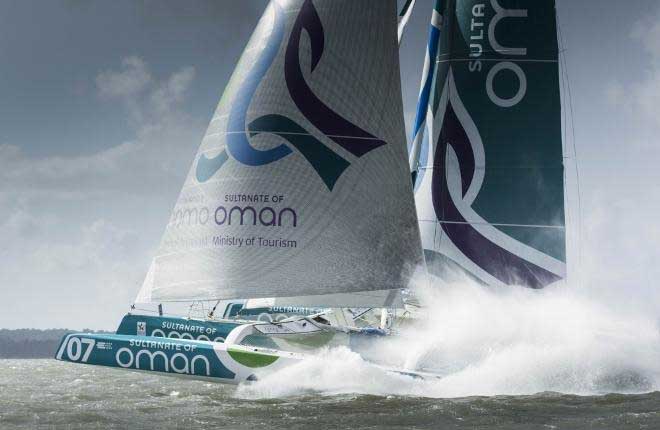
Musandam-Oman in record-breaking form
While Rambler is odds-on to be the first mono-hull to finish, it’s highly likely the oldest boat in the race, the beautifully-restored 43ft Tyrrell ketch of 1937 vintage, Darryl Hughes’ Maybird, will finish last on the water. He found himself in Dun Laoghaire marina berthed just ahead of Sidney Gavignet’s MOD 70 Musandam-Oman, and in the whirl of people up in the clubhouse, the Number One aboard Musandam, Derrynane’s favorite sailor Damian Foxall was relaxed in one of those constantly changing groups which at one stage included Darryl Hughes and northern sailing journalist Betty Armstrong, who is one of the few sailing journalists who has ever actually helmed a MOD 70.
Maybird looking tiny amongst assorted exotica in Dun Laoghaire Marina on Thursday evening. Yet once upon a time in the late 1940s, her sister-ship Aideen (below right) was one of the biggest yachts about the place.

Normally journos are padded up with safety gear like a sack of potatoes on the Mod 70s, for as we learned when one of them capsized in Dublin Bay in 2012, they’re so wide it’s dangerous to fall off them (the MOD 70s, that is…). But out in Valencia, when Betty was the journalist on board Musandam Oman for an inshore race, and she’d found herself a safe spot on the forward netting. Bur there was a straightforward sail back to the harbour, and Damian made his way forward and asked her back to the cockpit, and when she was there, he asked her would she like to helm: “There’s nothing to it”, said he.
So there was Mrs Armstrong of Bangor in County Down helming this wonderful machine at a very smooth 25–knots, and as she says: “Do you know what, there really was nothing to it. The boat was going so smoothly and there was so little feel in the helm that it was only the speedometer which could persuade me I was steering a sailing boat at 25 knots”.
In today’s Volvo Round Ireland 2016 race. they’ll be expecting more than 25 knots and conditions way beyond the “very smooth” once the big multihulls get the Fastnet astern and start to get a bit of north in their course. The weather pattern has moved on a bit from the conditions we were anticipating here on Wednesday, when there was talk of nor’easters at the start giving way to sou’westers by tonight. It now looks as though the ridge which was expected to cross Ireland during today will be slightly earlier than expected, and losing strength in its push to the northeast, thus at start time the underlying wind at Wicklow will be a slack nor’wester
Very soon, however, the weather will be dominated by a big wet low out in the Atlantic, though some comfort can be taken from the fact that pressure won’t become excessively low over Ireland. But the isobars will be close enough together to provide freshening breezes, and well before midnight tonight, the sou’westers will be established at the Tuskar, becoming strong during tomorrow all along the South and West coasts.
Thus getting to the turn in the Fastnet Rock/Mizen Head area is crucial (as it always is), but this year it’s especially the case. And of course while the MOD 70s and Rambler will be looking to have it ticked off well before noon tomorrow, anything much smaller will inevitably be facing a slugging match all the way from somehere north of the Tuskar Rock right down to Ireland’s great southwest capes.
BOATS TO WATCH
With a fleet of 64 boats, it’s impossible to give a complete form guide, so we’ll take ten from the body of the fleet which provide the winning combination of good all-round boats with able crew:
KATSOU (Alan Hannon, RORC & RUYC) This Reichel-Pugh 45 attracted much favourable interested in one of the premier berths at the RIYC on Thursday night, and rightly so. She comes with a good track record, and for this race she has a formidable crew built around the very best of the northwest from Lough Swilly YC, with Richie Fearon navigating (he navigated the winner Tanit in 2014) the winning Clipper Race Skipper Sean McCarter (he also was awarded the Cruising Club of America Rod Stephens Trophy for seamanship last year after successfully dealing with a man overboard in the North Pacific), and also Diarmaid MacAuley, one of the north’s best offshore helms.
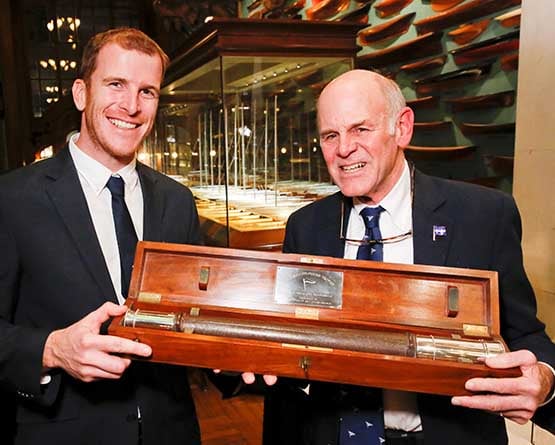
Sean McCarter of Lough Swilly YC receives the Cruising Club of America Roderick Stephens Award from CCA Commodore Tad Lhamon in New York, March 2015. McCarter will be sailing on Katsu during the Volvo Round Ireland Race
LISA (Michael Boyd, RORC & RYC). RORC Commodore Boyd has form in the round Ireland, he won in 1986, and Lisa certainly has form this year in beingin the frame in the RORC Championship. A First 44.7, she should cope well with the expected conditions.
EURO CAR PARKS (Dave Cullen, HYC). Also known as the Kelly family’s J/109 Storm, she has been chartered for this race by World Half Ton Classics Champion Dave Cullen and he has assembled a crew of six champions (himself included) from last weekends ICRA Nats. When you’ve the likes of Mark Mansfield, Maurice “Prof” O’Connell and Johnny Murphy sharing boat space, then good results are expected.
MOJITO (Peter Dunlop & Vicky Cox, Pwllheli SC) They’d a good second in last year’s Dun Laoghaire to Dingle Race, they’re one of the most consistent J/109s around, and they draw their crew from both sides of the Irish Sea in the best traditions of ISORA.
ROCKABILL VI (Paul O’Higgins, RIYC). Still something of an unknown force in her own right, Rockabill VI has the flawless pedigree of being a JPK 10.80 (Fastnet Race winner, Hobart Race class winner etc etc), so as they settle in the O’Higgins crew should move up the rankings
TEASING MACHINE (Eric de Turckheim, France). One of the world’s most sporting offshore racers, this 13m Archambault hs a go at everything from the Commodore’s Cup to the Sydney-Hobart, with a Fastnet thrown in for good measure. She’s always in the frame, she’s an amazing boat, and she and her crew will give of their best.
DESPERADO OF COWES (Richard Loftus, RYS) This vintage Swan 65 would be a good heavy weather selection. And she has a surprisingly competitive rating. She’ll be able to keep going with her crew in relative comfort while smaller craft are bouncing around with crew fatigue becoming a major problem.
AURELIA (Chris & Patanne Power Smith, RStGYC). The Power Smith’s J/122 is the Steady Eddy of the Dun Laoghaire fleet. She was the top-placed non-J/109 in last year’s Dun Laoghaire-Dingle in a race which might have been designed with the J/109 in mind, she has already won ISORA’s biggest race this year, and in all she is a boat which exudes competence.
BAM! (Conor Fogerty, HYC) Athough the Sunfast 3600 Bam! won her class in the RORC Caribbean 600 in February, with her owner subsequently sailing her single-handed from the Caribbean to the Azores when homeward bound, she is not a boat which is suited to the restrictive Irish Sea courses. But the wide open spaces of the Atlantic with winds abaft the beam will enable her to fly – it’s just getting down to the Fastnet that will be the hard bit.
CAVATINA (Ian Hickey, RCYC) The veteran Noray 38 Cavatina is the multiple Round Ireland winner most associated with Eric Lisson, but with her low rating and renowned staying power, if a flat patch happens to slow the whole fleet back, she’s always there, ready to pounce. While it seems unlikely this year, people have got Cavatina’s results prediction wrong before now.
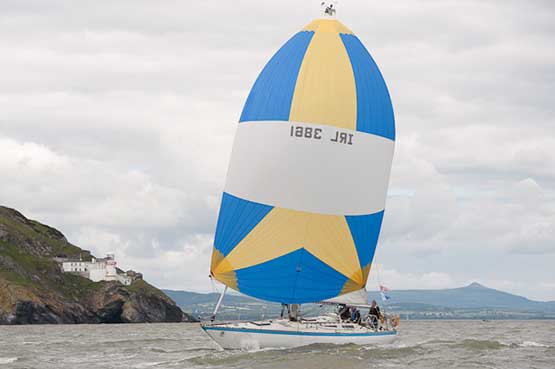
Ian Hickey’s Cavatina (RCYC) off Wicklow Head. She probably holds the record for most Round Ireland races sailed
The Volvo Round Ireland Race 2016 with its record fleet has the task of prediction made more complicated by the many sub-divisions, one of the busiest being the Open 40 Class which is within IRC, yet also races on its own, and for good measure some of the boats are fully-crewed while others are in the Two-Handed Division.
One of the most interesting of the latter is Roaring Forty 2, doing this race as Visit Brussels under the command of Belgian skipper Michael Kleinjans, who also happens to be the holder of the Round Ireland Single-Handed Record, which you can’t really compete for any more, as single-handed record sailing is now officially illegal in Irish waters. But it may well be that Kleinjans and his crew Ian Wittevrongel will set a two-handed Round Ireland Record in this race which will be worthy of future attention.
 Michael Kleinjens’ Open 40 Visit Brussels will be a favourite for line honours in the two-handed division. She is seen here zapping between two Figaro Solos
Michael Kleinjens’ Open 40 Visit Brussels will be a favourite for line honours in the two-handed division. She is seen here zapping between two Figaro Solos
Meanwhile, we’ll be carrying regular updates and comment on Afloat,ie HERE as the race progresses, based on the Race Tracker. We very much hope that by the time the time the prize-giving comes round in Wicklow on Friday evening, we’ll have mentioned every boat in the fleet at least once. But now, after partying on Thursday night (and a very good party it was too), there’s work to be done today, both off Wicklow and southward down the coast.
And in the end, it will all be in honour of the memory of the great Denis Doyle and his crew for their beautiful 1984 win and course record.
Denis Doyle and his crew aboard Moonduster after their great win in 1984. This photo was taken through glass in Wicklow SC, where it is on display in the Round Ireland Room. Has anyone any idea where the original neg might be sourced?
French skipper Sidney Gavignet’s crew of Omani sailors are no strangers to the 700 mile Round Ireland race track having famously smashed the record in 2015 after completing the course in 40 hours, 51 minutes and 57 seconds, some four hours faster than anything achieved previously. As a result, there will be an extra incentive for Kerry sailor Damian Foxall who despite previous bids was not onboard for the record breaking run last year. Foxall rejoins the crew for the Round Ireland in six weeks time and is very much looking to the multihulls debut in this year's offshore classic.
Fahad Al Hasni, Yasser Al Rahbi and Sami Al Shukaili were all on board for the record-breaking voyage and all return to action for the Round Ireland Race.
The team has developed a strong bond, says Gavignet so the prospect of lining up against other professional MOD70 crews in June for the start in Wicklow, to follow a course that leaves Ireland and all its islands excluding Rockall to starboard, serves to stir their competitive spirits.
“This Omani crew has a long history – last season especially was very demanding – so we have a very good team with a great team spirit,” said skipper Gavignet.
“We would like to win the race but know it will not be easy because the other MOD70s have been sailing a lot in the past few months. We have trained hard and the guys are performing at a different level now so we are very happy to go and do our best against the others.
“We hold the record but it is possible to do better and it is likely that whoever wins will set a new record, depending on the conditions. It is very exciting to be racing against Phaedo and Concise – it will be a good contest.”
Preparations for the race have included some intensive training offshore as well as participation in the Grand Prix Guyader in Douarnenez, France, last weekend where the Omani Diam 24 team onboard Oman Airports by Oman Sail finished in 3rd place.
This weekend MOD70 sailors Fahad, Sami and Yasser are due to compete on Oman Sail’s J80 at the Grand Prix Ecole Navale at the French Naval Academy in Lanvéoc to get some crucial fleet race practice.
Success in sailing against the clock for a speed record requires a different mindset to racing in a fleet, said Fahad, Oman’s most experienced and successful offshore sailor.
“Competing with other boats in the Round Ireland race will be different to breaking the record and probably a lot more difficult,” he said.
“The other MOD70s have been training and racing all year and have achieved some good results so they will be hard to beat. But we will be sailing the boat as fast as we can and if we can win, it will be fantastic for us because this is a two thirds Omani crew.”
Records are one thing but when you get two boats racing side by side, the results speak for themselves, commented Damian Foxall, acknowledged as Ireland’s most accomplished ocean sailor.
“This season, our campaigns are all about fleet racing. When you are racing against the clock, you never know if you are performing 100% but in fleet racing, if you are not going 100%, you probably aren’t winning. And you know pretty quickly whether you have taken a good or bad option.
“Fleet racing is more like a game of chess and what the other boats do on the course can affect your own tactics. So you have to be on your game 100% all the time and sail a lot harder. Our guys understand that completely.”
A couple of years ago, Musandam-Oman Sail would have been favourite to win the multihull class, Foxall continued but an upsurge in activity on the other MOD70s means they have a contest on their hands.
“The guys on Phaedo and Concise are sailing extremely well now so a couple of years ago, we might have been favourites but that is certainly no longer the case and we are going to have to compete really hard to get a result this year. But we know how to sail the boat so this is great and exactly how it should be.”






























